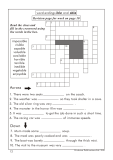Spelling Rules Book 2
SKU:
978-1-913884-12-3
€19.95
€19.95
Unavailable
per item
“I’d rather read than watch TV because now that I can read better, I want to read more.”
“This is a moment when the whole family realises what we’ve known all along that ‘learning feels good’.”
“Some children may need more help than their peers with spelling. They may not remember whole words but there is ample evidence that they will remember spelling rules.”
Spelling Rules Book 2
Helps pupils to make sense of and remember common spelling rules. A variety of consolidation activities follow each rule or spelling pattern. Covers 15 spelling rules and patterns including plurals, difficult endings, prefixes and suffixes. Includes teaching notes and checklists (74 pages).
Many of the worksheets start with a written spelling rule which focuses on the salient feature of the spelling pattern. It is essential that the rules be emphasised by the parent / teacher and that examples be given. Pupils who experience difficulty with spelling generally find a measure of security in the learning of rules and the mastery of just a few of them will often increase the pupil’s confidence and improve the self-image.
Exceptions to many of the rules are highlighted. Not all exceptions are provided. In the main work is provided for those which pupils are most likely to write.
The accommodation of some spelling rules may be helped by the pupil drawing a picture to represent the rule.
The difference between oracy and spelling skills often results in frustration of being unable to put thoughts onto paper in an acceptable manner.
This may result: -
“This is a moment when the whole family realises what we’ve known all along that ‘learning feels good’.”
“Some children may need more help than their peers with spelling. They may not remember whole words but there is ample evidence that they will remember spelling rules.”
Spelling Rules Book 2
Helps pupils to make sense of and remember common spelling rules. A variety of consolidation activities follow each rule or spelling pattern. Covers 15 spelling rules and patterns including plurals, difficult endings, prefixes and suffixes. Includes teaching notes and checklists (74 pages).
Many of the worksheets start with a written spelling rule which focuses on the salient feature of the spelling pattern. It is essential that the rules be emphasised by the parent / teacher and that examples be given. Pupils who experience difficulty with spelling generally find a measure of security in the learning of rules and the mastery of just a few of them will often increase the pupil’s confidence and improve the self-image.
Exceptions to many of the rules are highlighted. Not all exceptions are provided. In the main work is provided for those which pupils are most likely to write.
The accommodation of some spelling rules may be helped by the pupil drawing a picture to represent the rule.
The difference between oracy and spelling skills often results in frustration of being unable to put thoughts onto paper in an acceptable manner.
This may result: -
- Work avoidance strategies – poor organisation of equipment, deliberately dropping equipment on the floor etc.
- Poor handwriting to disguise poor spelling skills.
- A very poor work rate, where written work is concerned and stilted written work which does not reflect potential.






